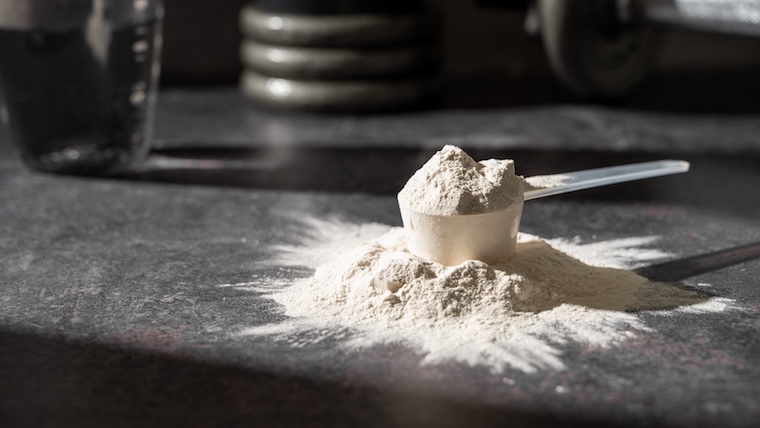The human body naturally produces creatine in the liver, kidneys, and pancreas, supplying energy to muscle cells, especially during brief periods of high-intensity activity. Creatine is also found in protein-rich foods like red meat and seafood, and is widely available as a supplement, often used to help build lean muscle mass and improve athletic performance. (1)
A 2025 study sparked debate about whether creatine consistently increases lean muscle mass in untrained individuals.
New Study on Creatine
The 2025 study focused on healthy, untrained individuals, including men and women, over 12 weeks. Participants began with a one-week wash-in phase, during which they were given either a placebo or a creatine supplement. Following this, they completed a 12-week resistance training program. (2)
Researchers used DEXA scans (dual-energy X-ray absorptiometry) to measure lean body mass, bone density, and body composition at three time points: the start of the study, after the initial week of creatine supplementation, and at the end of the 12-week training program. The key findings are were:
- Creatine supplementation increased lean body mass compared to the placebo group.
- On average, participants gained half a kilogram of lean mass.
- No significant differences were observed between the placebo and creatine groups during the resistance training phase.
These results suggest that the increase in lean mass from creatine occurred primarily during the initial week, likely due to water retention rather than muscle growth. This raises questions about the long-term effects of creatine supplementation.
However, Dr. Layne Norton highlighted that a wealth of evidence supports creatine’s benefits, including increased lean mass, improved strength, enhanced performance metrics, and cognitive advantages. (3)
Creatine Is an Osmolyte
Creatine’s impact on lean mass is likely due to increased intracellular water. As an osmolyte, creatine draws water into cells, which directly refutes claims made by non-science-based companies that their products don’t cause water retention.
The intracellular retention of water is the anabolic component of creatine.
—Dr. Layne Norton
One limitation of this study was its focus on individuals without prior training.
“There may be an effect of creatine during resistance training, after the wash-in period, not just in the initial phase,” Dr. Norton explained. “But untrained people have such a robust response to resistance training that perhaps it would have just washed out the effect of creatine, and they couldn’t pick out the differences between the groups. If they had been resistance-trained individuals, they might have seen more differences.”
Many assume a supplement provides a specific benefit without considering their baseline levels. Creatine, for example, establishes a new baseline for lean mass and strength, and doesn’t continue to increase linearly over time. This is why some may not notice any benefits after prolonged use.

Creatine may lead to an average gain of around one pound of intracellular water. Although it may not increase fibrous tissue, intracellular water is still considered lean mass. M
uscle cells comprise about 70% fluid, so naturally growing the fluid within them causes them to expand. This means larger muscle cells — and by extension, bigger muscles — by default. It’s all lean mass, even if it’s not strictly connective or contractile tissue. The added volume still enhances the appearance of muscle size.
Is Creatine Effective?
Creatine won’t make you look jacked like steroids might, but that doesn’t mean it isn’t effective. Research suggests that the initial gains in lean mass and strength from creatine supplementation may reflect the body’s adjustment to a new baseline.
These improvements aren’t necessarily long-lasting, but would you rather gain an extra pound of lean muscle and a bit more strength, or none at all?
Dr. Norton recommended sticking to creatine monohydrate, the most thoroughly researched and proven form. (4) While some individuals may experience mild gastrointestinal discomfort when taking it, splitting the dose can easily resolve this issue. To minimize side effects, divide the standard five-gram dose into two smaller doses—one in the morning and one in the evening.
More In Research
- The Scientifically Correct Number of Sets Per Workout
- Can We Determine the Limit of What a Human Can Lift?
- Beef Actually Isn’t Bad for Your Heart?!
References
- Hall, M., Manetta, E., & Tupper, K. (2021). Creatine Supplementation: An Update. Current sports medicine reports, 20(7), 338–344. https://doi.org/10.1249/JSR.0000000000000863
- Desai, I., Pandit, A., Smith-Ryan, A. E., Simar, D., Candow, D. G., Kaakoush, N. O., & Hagstrom, A. D. (2025). The Effect of Creatine Supplementation on Lean Body Mass with and Without Resistance Training. Nutrients, 17(6), 1081. https://doi.org/10.3390/nu17061081
- Kreider, R. B., & Stout, J. R. (2021). Creatine in Health and Disease. Nutrients, 13(2), 447. https://doi.org/10.3390/nu13020447
- Buford, T. W., Kreider, R. B., Stout, J. R., Greenwood, M., Campbell, B., Spano, M., Ziegenfuss, T., Lopez, H., Landis, J., & Antonio, J. (2007). International Society of Sports Nutrition position stand: creatine supplementation and exercise. Journal of the International Society of Sports Nutrition, 4, 6. https://doi.org/10.1186/1550-2783-4-6
Featured image via Shutterstock/Erhan Inga